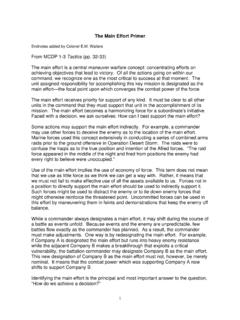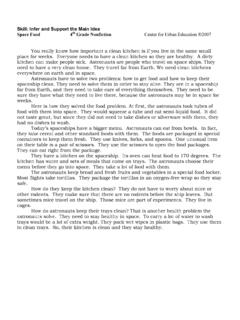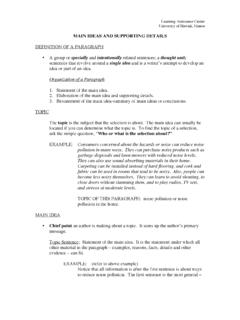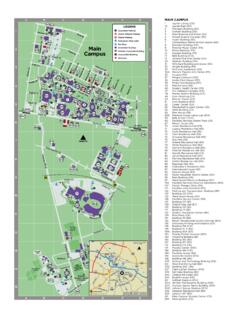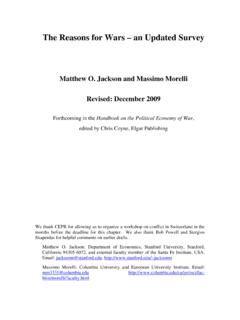Transcription of Bearing Failure Analysis Guide CL77-3-402
1 Engine Bearing Failure & Analysis GuideClevite 77 IssueForm # CL77-3-402A Guide to Analysis and correction ofpremature engine Bearing failuresEngine Bearingfailure analysisguideEngine Bearing Failure & Analysis GuideCRANKCASE TOLERANCESF inish of main Bores: 60-90 micro inches Tolerance: .001 (.025mm) up to (250mm) boreOut-of-Round: .001 (.025mm) maximum if horizontal is larger thanverticalAlignment: .002 (.050mm) maximum overall misalignment (.001 for heavy duty or highly loaded engines) .001 (.025mm) maximum misalignment on adjacentbores (.0005 for heavy duty or highly loadedengines)CRANKSHAFT TOLERANCESMAIN Bearing AND CRANKPIN JOURNALSF inish of Journals: 15 micro inches Ra or better (10 micro inches Ra orbetter for heavy duty or highly loaded engines)Diameter Tolerance.
2 0005 (.013mm) up to (38mm) journal .001 (.025mm) for (38mm) to (250mm)journalOut-of-Round: .0005 (.013mm) maximum up to (125mm) journal(.0002 for heavy duty or highly loaded engines) Never use a maximum out-of-round journal with amaximum out-of-round : .0002 (.005mm) maximum up to (25mm) longjournal (.0001 for heavy duty or highly loadedengines) .0004 (.010mm) maximum for (25mm) to (50mm) long journal (.0002 for heavy duty orhighly loaded engines) .0005 (.013mm) maximum for (50mm) or longerjournal (.0003 for heavy duty or highly loadedengines)Alignment: .001 (.025mm) maximum misalignment on adjacentjournals (.0005 for heavy duty or highly loadedengines) .002 (.050mm) maximum overall misalignment (.001 for heavy duty or highly loaded engines) Crankpin and main journals should be parallel (.)
3 025mm)(.0005 for heavy duty or highlyloaded engines)Hour-Glass or Barrel Shape Condition: Same as taperOil Holes must be well blended into journal END CLEARANCES haft DiameterEnd (50mm-70mm).003 (. ) (71mm-88mm) .005 (. ) or over (89mm or over) .007 (. )CONNECTING ROD TOLERANCESF inish of Rod Bores: 60-90 micro inchesRod Tolerance: .0005 (.013mm) up to (81mm) diameter .001 (.025mm) from (81mm)to (250mm)diameterOut-of-Round: .001 (.025mm) maximum if horizontal is larger thanverticalTaper: .0002 (.005mm) up to (25mm) length (.0001 for heavy duty or highly loaded engines) .0004 (.010mm) for (25mm) to (50mm)length (.0002 for heavy duty or highly loadedengines)..0005 (.013mm) for (50mm) or longer (.0003 for heavy duty or highly loaded engines)Hour-Glass or Barrel Shape Condition: Same as taperParallelism between rod bore and wrist pin hole.
4 001 (.025mm) in (125mm)Twist .001 (.025mm) in (150mm)CONNECTING ROD END CLEARANCEF illets at end of crankpin should not bind on ends of rodbearing, .004 (.10mm) to .010 (.25mm) clearance SPREADMain bearings: .005 (.13mm) to .020 (.50mm) in excessof crankcase bore diameterConnecting rod bearings: .020 (.50mm) in excess of rodboreOIL CLEARANCE - RESIZED BEARINGSThe oil clearance shown in this catalog are for the factorymanufactured precision sizes. When installing a resizedbearing, adjust the oil clearance shown as follows:For babbitt and TM-77 copper-lead:Add .0004 (.010mm) to both low and high limitFor TM-112 copper-lead:Add .0008 (.020mm) to low limit and .0004 (.010 mm) tohigh limitPIN BUSHINGSR esizing:Light Ream: .007 /.015 Bore: .015 /.030 Recommended BearingInstallation TolerancesiEngine Bearing Failure & Analysis GuideAs you know, every automotive engine part will eventually wear out.
5 And if every part always performed for thefull length of its expected life, your job would be fairly simple.. to replace parts that have worn. Unfortunately,we cannot always count on an engine part failing only because its normal lifespan is exceeded. A mechanicmust not only be a replacer of parts but, like a doctor, he must be capable of diagnosing his patient to deter-mine why a part failed prematurely. The table below lists the eight major causes of premature engine bearingfailure, along with percentage figures which indicate how often each has been found to be the prime contributorto a Bearing s destruction. However, it is important to note that in many cases a premature Bearing Failure is dueto a combination of several of these CAUSES OF PREMATURE Bearing .. Lubrication .. Journal Finish.
6 We can reason that if a mechanic merely replaces a damaged Bearing in an engine, without determiningthe cause of its Failure , more than 99% of the time he will be subjecting the replacement Bearing to the samecause that was responsible for the original Failure . What this all means is that just as a doctor cannot cure apatient until he has determined what ails him, so, too, a mechanic cannot correct the cause of prematurebearing Failure until he first determines what causes the pages of this manual are organized, for your convenience, into four major subjects:1. Appearance an illustration and brief description of a Bearing that has failed due to a specific Damaging Action what actually damaged the Bearing under the conditions which were Possible Causes a listing of those factors capable of creating the particular damaging Corrective Action the action that should be taken to correct the cause of believe you will find this reference manual easy to read and use, and that it will be very helpful to you inproperly determining the cause of premature Bearing Bearing Failure & Analysis GuideNORMAL WEAR.
7 PAGE 1 FOREIGN PARTICLES IN LINING .. PAGE 3 FOREIGN PARTICLESON Bearing BACK ..PAGE 4 SHIFTED Bearing CAP .. PAGE 6 EXCESSIVE PAGE 7 INSUFFICIENT PAGE 8 BENT OR TWISTEDCONNECTING ROD .. PAGE 9 FILLET RIDE .. PAGE 10 DISTORTED CRANKCASE .. PAGE 11 BENT CRANKSHAFT .. PAGE 12 Quick Reference IndexiiiEngine Bearing Failure & Analysis GuideOUT-OF-ROUND BORE .. PAGE 13 OUT-OF-SHAPE JOURNAL .. PAGE 14 OIL STARVATION .. PAGE 15 HOT SHORT .. PAGE 16 SURFACE FATIGUE .. PAGE 17 CORROSION .. PAGE 18 ACCELERATED WEAR .. PAGE 19ivEngine Bearing Failure & Analysis Guide1. Check all connecting rod housing bores for taper,roundness and size, using a bore gauge or insidemicrometer. Check for parallelism between the largeand small ends of rod. Check condition of bolts Check main Bearing bores for alignment, taper,roundness and size.
8 Check condition of bolts Make sure that engine block and crankshaft areclean, checking oil passageways for hidden dirt anddebris. Hot water and detergent work best for While installing both connecting rod bearings andmain bearings, check for proper oil clearance, usingClevite 77 Plastigage *.Uniform wear pattern over approximately 2/3 of the Bearing s surface. Wear should diminish near the partingline ends of the Bearing , and the wear pattern should extend uniformly across the Bearing in the axial AppearanceCRANKSHAFT & ENGINE Bearing INSTALLATION GUIDELINES1 Engine Bearing Failure & Analysis Guide5. With engine block upside down, install the uppermain halves, making sure Bearing backs and boresare clean and Check oil hole alignment to insure proper oil Lubricate all bearings and seal lip surfaces usingClevite 77 Bearing Guard**.
9 Bearing Guard can beused on any internal engine component as anassembly Place the crankshaft squarely into the mainbearings and assemble lower main bearings andcaps. Check to insure proper Pry crankshaft squarely into the main bearingsand assemble lower main bearings and caps. Checkto insure proper Assemble the connecting rod and piston assem-bly to the crankshaft, using Clevite 77 Bolt Boots toprotect crankshaft journals and cylinder walls. Makesure caps match correct rods, and torque bolts toproper OE With crankshaft forced all the way forward inblock, check end clearance between the crankshaftthrust face and the Bearing flange to OE specifica-tion, using a feeler gauge of proper Prime engine oiling system before starting engineto assure operation of oil pump and lubricationsystem immediatey upon start-up.
10 * Part #MPG-1,.001 ; #MPR-1, .002 ; #MPB-1, .004 ; #MPY-1,.009 ** Part #2800B2 - 8 oz. bottle; #2800B4 - 1 gal. jug; #2800B5 - 1 1/3 oz. pkg. Part # 2800B12 Engine Bearing Failure & Analysis GuideAPPEARANCEF oreign particles are embedded in the lining of the Bearing . Scratch marks may also be visible on the ACTIONDust, dirt, abrasives and/or metallic particles present in theoil supply embed in the soft babbitt Bearing lining, displac-ing metal and creating a high-spot may be large enough to make contact withthe journal causing a rubbing action that can lead to theeventual breakdown and rupture of the Bearing particles may embed only partially and the protrud-ing portion may come in contact with the journal and causea grinding wheel CAUSES1. Improper cleaning of the engine and parts prior to Road dirt and sand entering the engine through the air-intake manifold or faulty air Wear of other engine parts, resulting in small fragments of these parts entering the engine s oil Neglected oil filter and/or air filter ACTION1.

